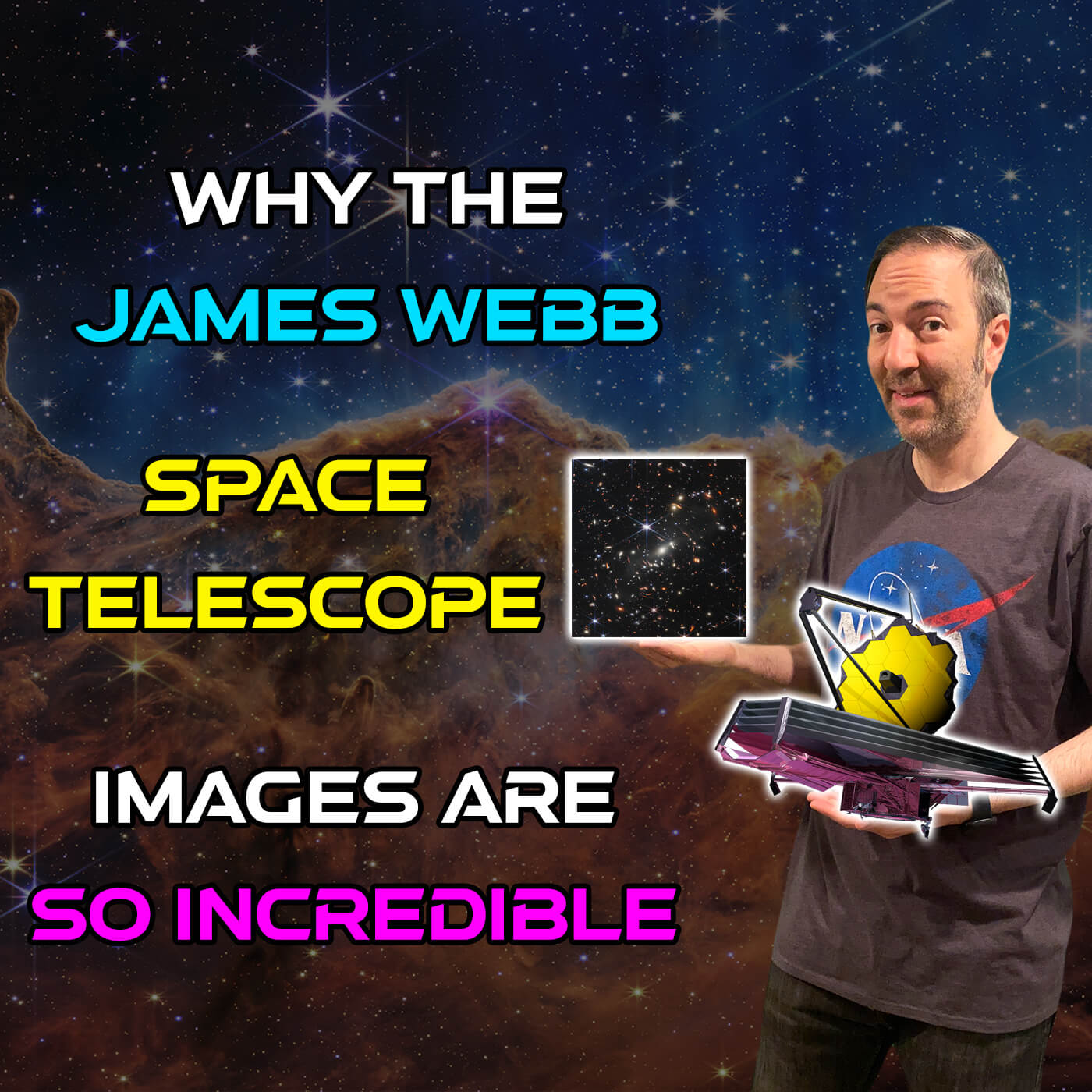Future Tech: Why the James Webb Space Telescope images are so incredible

In this episode of Future Tech, I talk about why the James Webb Space Telescope images from NASA are just so amazing and incredible. Scientists have compared one of the images that have been released to holding a grain of sand in your hand. This cluster of galaxies known as SMACS0723 is the result of that “grain of sand”. That It’s over 13 billion years old, and shows us what happened right after the Big Bang. I’ll talk about this image and the others as well, so tune in Earthlings! This episode is sponsored by the world’s first productivity shot, Magic Mind. Pick some up at magicmind.co/boots and use my code BOOTS20 to get 20% off your order or 40% off your subscription within the next 10 days!
Listen to the Podcast episode here:
Or Watch the Video here:
Here’s the transcript from this podcast episode, please excuse any typos!
For those of you who don’t quite understand what you’re looking at, it is, you know, a couple 100 million years after the Big Bang happened. We’re seeing the galaxies that were forming right after that, you know, after the Big Bang, there was this cosmic dawn. It was like this dense fog of primordial mass and light can’t reach us from that area because it’s all like the cosmic Dark Ages. After the Big Bang, we’re not exactly sure what took place besides, the actions between glasses and stars started forming and planets started forming and gasses and elements started becoming galaxies. So by seeing S Max 0723, that galaxy photo that is the multiple Galaxy photo, actually seeing what happens right after that. Extremely important, the fact that the light had to travel to us over 13 billion years because, you know, light travels, you know, 186,000 miles per second. It had to travel to us. So the telescope is actually looking back in time. If you think about it, the telescope is seeing light that traveled to us over 13 billion years ago. And we’re seeing it now. Same goes for the Carina Nebula, which was an area of star formation. It looks like orange mountains. If you look at that photo, it’s one of the most beautiful photos I’ve ever seen. wallpaper and again, it seemed back in time. It’s a nebula and now we’re also looking at the quintet of galaxies that the JW S T captured. It’s called Stephens quintet. That shows five galaxies, two of them colliding and like maybe merging, right and we couldn’t see these things. before. You know, the Hubble Space Telescope is a little over seven feet or a little less than eight feet 7.8 feet, and the J ws T is 21.3 feet. So it has six times more light collecting area. And this means that it can capture more imagery, more light which gives it a much clearer image. Plus, the Hubble is using a double UV standard . I can see JPL ust NASA decided to go with infrared light, which can look through these dense clouds of dust and gas. It can see stars behind these clusters of fog. It can see distant universes because it’s capturing infrared light which is extremely, you know, bright to infrared light and even the faintest light 13 billion years ago can capture that because it can see the infrared.
Now, some people were asking me, “Why is that image warping? Why are the galaxies spread out? Why are they bent? And this is actually something it goes back to Albert Einstein, Albert Einstein predicted the effect of something called gravitational lensing over 100 years ago, and basically it’s space getting warped by a lens that we look through. So imagine looking through a lens and it’s like warping it. So let’s say you see some galaxies right and in the case of the S max 0723 Image of all the galaxies there are, there’s light from the galaxies behind the cluster. Okay, so the Webb telescope is seeing a distorted version of the galaxies because it’s like having a camera lens. The galaxies are providing a camera lens. Between the telescope and the galaxies behind them. So think of it like this. In the image, you might see 10,000 galaxies, I’m just putting the number out there. I know it’s a billion or whatever. Let’s say 10,000 galaxies are in the foreground of the image. Those galaxies are a lens to the other million galaxies behind them, which dwarfs them. It’s actually really freaking cool. Scientists are really excited about the infrared capabilities as well as the fact that it can study exoplanets. Now this is where things, at least in my opinion, get very interesting. Before we were only able to see the gravitational pull of a star, a sun see, it’s far now we’re able to observe the stars that those exoplanets are orbiting means the light that’s passing through the star is acting like a filter through the planet’s atmosphere. So we can study that light, we can study it from the filter and we can actually finally study the composition of the atmosphere on those exoplanets. So just imagine billions of planets and trillions of stars, we can finally start to find out what kind of atmosphere these planets have in other galaxies. Are they habitable? Do they have oxygen? Is there water, which they found on one planet where an exoplanet had water on it? This is huge by studying the atmosphere and the gas properties, and the temperatures of these planets, we will finally be able to find potentially habitable planets.
Because although we’re going to the moon and Mars that’s already in the works with the Artemis mission, and Elon Musk’s SpaceX is really on his way to Mars. They’re not habitable. We have to build these Habs and we have to live on the ships and we have to terraform planets and these are going to take 100 years to do so in our lifetimes. We’re not going to be visiting these plants. Not to mention we don’t travel yet, which means it’s going to take two years round trip including stationing on Mars. So without Lightspeed travel, we’re kind of first round with the Webb telescope, we can look back in time and we can find these habitable planets. So it’s, you guys have to really understand how interesting and incredible these images really are. One of the oldest questions humanity has been asking is, where did we come from? What are we? Are we even, you know, living beings? We are just energy formed from atoms. Look, the Big Bang happened. We don’t know where that came from. We don’t know what happened before the Big Bang. Was it a couple of aliens throwing marble in the marble game and one of them exploded and turned into our galaxy? What is the expansion of the universe? It just keeps expanding because of the explosion of the Big Bang is if you really think about it, the universe is basically just an explosion. And it’s just still exploding. Although from what I understand it has slowed down. And also 95% of the stars and planets and galaxies that the Big Bang was going to provide us have been created.
Apparently, we’re at the tail end of the creation, which again, this is all very interesting to understand, but also kind of hard to understand in a way. Where did we come from? And we’re trying to find that out. The closer we can get to the Big Bang, which the Webb telescope is going to get us, the more understanding we will have as to what we are, what is earth? What are what’s the Milky Way galaxy that we’re in? What are the other galaxies? What are black holes? Are we alone in the universe? Are there other habitable planets out there? Are there wormholes? Is there a way to travel through space quicker? I mean, these are all potential questions that we, as humans have been wanting to know for centuries or 1000s of years. And now we finally have a technological advancement that’s going to get us there. And I don’t think a lot of people understand that. I really don’t. And that’s why I wanted to do this episode. In my mind, the people at NASA had been working on this project for decades. I don’t think anyone understands that either. It was a $10 billion telescope, you know, $10 billion people have dedicated their entire lives. To build this telescope. There have been budget, budgetary delays, technical delays. There were so many issues and the fact that they were able to finish the telescope tested on the ground, make sure it would open up properly and calibrate properly, launch into space without any problems. Deploy the telescope, slowly unraveling it and opening it up over time because it took time in the Lagrange point between the Earth, the Sun and the Earth, and so it’s blocking out the sun with the tennis court size Sun shields. The fact that they were able to build all of this, get it up in space without any issues, to me, is extremely impressive. And now we’re reaping the rewards. Now we’re seeing the imagery that this telescope promises and the data that we’re receiving from these images, because keep in mind, we mere mortals aren’t just seeing the images as eyes. But the scientists at NASA and all the other scientific communities or organizations that are privy to the data that the telescope is sending back because they’re getting all sorts of data. They’re getting atmospheric conditions, is there water, chemicals, you know, light, light can tell a lot of stories because there’s a lot of different types of light. I mean, they must be getting a ton of data. I want to know more about that. But in the meantime, at least we get to see the beautiful majesty of the universe, as it was just a couple of 100 million years after the Big Bang. So be impressed. Be curious, be excited. Keep your eyes peeled. For more James Webb Space Telescope images like the one they released of Jupiter and its moons. That’s cool because it looks extremely clear. And I love seeing stuff like this, so I can’t wait to see more. What are you guys excited to find out about the Webb telescope? Tell me in the comments. What did you like about the images that you did? See, I want to talk to you about it. And as always, I will see you in the next episode.
![]()





